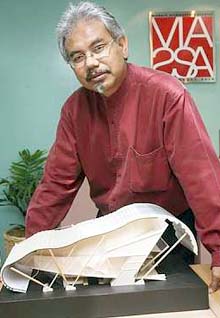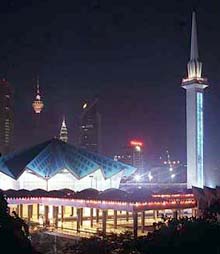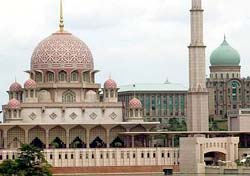 |
|
Prof Dr M. Tajuddin has many sensible, forward thinking ideas on
Malaysian architecture.
|
Why do Malaysians live in neighbourhoods that are people-unfriendly,
alienating and lacking in security and ease of movement? An
architectacademic who has long been a vocal critic of the way our homes,
neighbourhoods and even cities are built tells ANDREW SIA how – and why – we
must do better.
IT took a brave soul to publicly declare that the Prime Minister’s office
complex in Putrajaya looks “imperial, palatial and less democratic” compared
to Parliament. Especially when everyone else was singing praises of the
spanking new building.
So who was this lone voice daring enough to criticise the complex for
drawing on the Malay-Muslim identity only instead of a more universal
modernist outlook like the Parliament building?
What’s more, he took exception to its lack of sun-shading devices which
made it more wasteful in (air-conditioning) energy, thus reflecting less
concern with financial and ecological accountability.
This is Prof Dr M. Tajuddin M. Rasdi, 44, of Universiti Teknologi
Malaysia, Johor. If you call him a maverick, he will not disagree. Yet, he
makes it clear that he is not being difficult or critical for personal glory
but because he believes passionately that architecture plays an immensely
vital role in society and nation-building.
How we live, work and play together in harmony and safety – or not – is
very much affected by the built environment that surrounds us.
His idea of a good lecture is to make his architectural students walk
through Malaysian housing estates for three days so that they can
experience, first hand, the searing heat, the pelting rain the dangerous
driving, and hopefully design something that is more people-friendly.
He has designed a 500-unit housing estate where children can cycle or
walk to the school, playground, mosque, community centre and shops without
crossing a single street. (see diagram below)
But that has remained on paper. Instead he is frustrated “to see so much
money being spent on a shiny ‘jewelled’ city complete with man-made lakes,”
clearly referring to Putrajaya.
“Maybe it’s an excuse to build an ‘Islamic bridge’. And yet we seem to
not have enough money for pavements!”
Bold statements indeed from a Malay-Muslim architect. What’s his take on
Islamic architecture?
He thinks that the Putrajaya Mosque is “arrogant and monumental”, a
regressive copycat of an “Arabian Nights” fantasy compared to the
well-thought out, eco-friendly, relaxed and humble National Mosque in Kuala
Lumpur.
Showy “onion domes” and arched bridges are not the real core of Islamic
architecture, he says. Rather, it should be about human-friendly values.
Mosques should be made more alive as community centres by building teh
tarik stalls and libraries next to them, for instance. Citing the
renowned Islamic scholar Ibnu Khaldun, for instance, Dr Tajuddin underlines
that Islamic cities should be well-ventilated.
Yet despite speaking to many leaders of Umno and Pas, he finds that:
“They are both competing to make grandiose statements of Islamic
architecture without caring much about its humanistic aspects. The exception
seems to be the Kelantan Mentri Besar (Datuk Nik Abdul Aziz Nik Mat). After
my talk, he gave the go-ahead to build a mosque with Chinese-like
influences.”
Dr Tajuddin is equally at home with both Western and Islamic/Malay
discourses.
“You will not find many architecture academics who would dare mention
(Frank Lloyd) Wright and Islamic architecture in one breath,” he says.
 |
|
The National Mosque is architecturally more “eco-friendly and humble”
compared to the Putrajaya Mosque.
|
His reason for this: “My study of Islam was unorthodox. From Form Two
onwards, I was freed from the stereotyped views of Malay Islam from schools
because I learnt directly from the Prophet through the (translated) Hadiths
and not through some civil servant ustaz.”
He has been influenced by Abul A’la Maududi and Syed Qutb, whom he calls
great political reformists of the 20th century.
“My political views of Islam are quite synonymous with the democratic
ideals of (architects Louis Henry) Sullivan and Wright.”
His credits his non-racist attitudes to various factors, such as his
upbringing by his policeman father and his multi-racial childhood friends at
the Butterworth police barracks.
“We would catch tadpoles and fighting fish from the big parit
(ditch), sail paper sampans in the longkangs (drains) and ride
bicycles to second hand-book shops. We played hide and seek, police and
thief, had shooting battles, roller-skated and slept out in the corridors to
watch for shooting stars. At St Mark’s Primary School, I remember a 40-60
make up of non-Malays and Malays. So I had a racially balanced upbringing.”
He then attended Hua Lian School in Taiping, where he was one of four
Malay students amongst 2,000 Chinese students.
“I never felt mistreated or misplaced at Hua Lian. Terima kasih, cikgu!
I was the only student with an A in 121 English. Bahasa Malaysia dapat C5!”
When he attended the University of Wisconsin, in the United States, he
began a personal study of comparative religions and deepened his study of
Islam.
“In Islam, any sense of racial superiority vanishes totally. I learnt
that man was created to be moral and that skin colour bears no reward in
front of Allah. It was that simple.”
He has described himself as an “architect with a conscience” who merely
wants simple, sensible and practical architectural solutions to promote
everything from children’s safety and inter-racial harmony to cooler homes
and safer neighbourhoods.
Why aren’t these ideas taken up in Malaysia?
For one, the national priority is on glorious showcases such as the
Petronas Twin Towers.
“Politicians believe in the mirage effect. So money is spent to build
wonderful hallucinations which may obscure real problems in society.”
“Many architects wait like beggars on the sidelines, hungrily snapping up
whatever projects they can get. So not much thinking goes into low cost
housing or even ‘your-cost’ housing!” he says.
 |
|
The Putrajaya Mosque is said to be “arrogant and monumental” in
architectural terms.
|
And secondly, the system is resistant to change.
“A developer once told me that it is impossible for a new idea to get
through to the higher authorities when a clerk with an SPM certificate
handles the first level of evaluation.
“Perhaps architects don’t even bother because the authorities already
have so many set guidelines and procedures. Or perhaps a visionary architect
was turned down by developers calculating their square foot and profit
margins.
“I don’t have the experience of working on real projects but I do know we
can do much better. Right now, developers lack vision, architects lack
professional guts and authorities are too arrogant to listen to ideas. If
people disagree with me, then prove me wrong. Please.”
Even local universities, which are supposed to be the cradles for
innovative thinking, fall short.
“Our universities, by order of those in power, produce polished screws
and nuts as graduates. Racial polarisation is at its worst, students cannot
debate coherently, student campus politics are a sham and university
publishers find difficulty getting lecturers to write books. And we are
worried about international university rankings?”
Dr Tajuddin adds, “Ninety per cent of academics are sitting in their cosy
classrooms” and are less concerned about educating the public on better
housing design as it counts for “very little” in promotions. Others who want
to contribute to the community are scared off by the University and
University Colleges Act.
He candidly says that getting his professorship was a struggle.
“The first time I was interviewed, there were four other candidates. I
saw that I was the only one with a heap of books to my name. The others had
not a single book. I was the only one who was later denied the promotion,”
he recalls.
But even after getting into the establishment, so to speak, Dr Tajuddin
has no intention of mellowing or quieting down. He feels he has a mission
and that is explain to policy makers, implementers and ordinary people why
we all deserve better when it comes to our built environment.
The amazing thing is his ideas are not impossible but common sense
solutions to our woes. Take his proposals for a good housing estate, for
example:
Why can’t we eliminate the back lanes in housing estates? It’s a haven
for crime. And houses are so close together that backroom curtains have to
be permanently drawn.
Terrace houses, he says, can be redesigned as clusters, so that every
unit becomes a corner lot with a little side garden.
A housing estate also need not be so car-focused. It should have
pavements, where we can walk away our cholesterol enroute to nearby shops.
Along the way, we can stop by little shady rest stops, burger kiosks and
newspaper stands and get to know fellow residents better.
If all that makes sense then why are we settling for Putrajaya when we
can get Utopia?